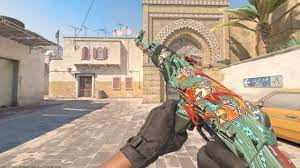Many of us have come across platforms dedicated to skin trading. What is it? If it’s simply a means to acquire skins in CS2, why is it so widespread? Indeed, it is one of the popular methods to obtain skins in the game, but there are a few other aspects to consider. In this article, we plan to provide you with a guide on CS2 skin trading. We will discuss what it is, how it is done, the methods available, and the advantages. Finally, we will address the long-awaited question: is skin trading profitable? If you are ready, let’s dive in.

What is Skin Trading in CS2?
Skin trading is a feature that allows players to exchange items, known as skins, with each other. Skin trading has become a significant aspect of the CS2 community, enabling players to buy, sell, or swap their skins on various trading platforms. The value of skins can vary based on factors such as rarity, popularity, and condition.
Skin trading typically takes place on the Steam Marketplace or other external platforms that offer trading services for players. Detailed information about both will be provided below.
How to Start Trading with Skins in CS2?
Alright, let’s say you want to trade your skins. How to trade CS2 skins? You follow some simple steps to make it happen. Here they are:
Creating a Steam Account
The Steam Market is a platform within the Steam ecosystem where users can buy and sell in-game items, including CS2 skins, using Steam Wallet funds. On the Community Market, players can list their items for sale or purchase items listed by other users.
Creating a Steam account is a straightforward process that allows you access to a vast library of games and other features. To get started, visit the Steam website and click on the “Join Steam” button. You’ll be prompted to fill in your email address, create a unique username, and set a secure password. Afterward, Steam will send you a verification email; simply follow the provided link to verify your account. Next, download and install the Steam application on your device. Once installed, log in with your newly created account details. Congratulations, you now have a Steam account, opening up a world of gaming possibilities, social features, and access to the Steam community.
Understanding the Steam Market & Community Market
Both the Steam Marketplace and the Community Market operate on a supply-and-demand basis, influencing the prices of skins. Sellers play a crucial role in this ecosystem as they set the prices for their listed items, considering factors such as skin rarity, condition, and overall demand. Buyers, on the other hand, have the flexibility to choose from a variety of available listings. This competitive environment allows for market-driven pricing, where the value of skins is determined by the interactions between buyers and sellers.
When it comes to transactions on the Steam Market, sellers should be aware of a nominal fee imposed by the platform. This fee is a small percentage of the transaction amount and is deducted to support the overall infrastructure and services provided by Steam.
Introduction to CS2 Trading Platforms and Websites
Players can also utilize external trading platforms or websites to trade skins. In general, these are external online platforms that facilitate the buying, selling, and trading of in-game items, such as skins. The process is simple: users list their skins for sale or browse listings to purchase desired items, and transactions often involve real money. Unlike Steam, third-party platforms may offer a broader range of payment options, including credit cards, PayPal, and cryptocurrency. Many platforms also facilitate direct skin-to-skin trading between users, which allows players to exchange items without the need for monetary transactions. Similar to the Steam Marketplace, the prices on third-party platforms are influenced by market demand, rarity, and the platform’s policies.
There are a few disadvantages to selling and buying skins online from third-party platforms, however. There are many scam cases, and since these types of platforms are not operated by Valve or the CS2 administration, attempts to recover your money or skins from scammers usually fail. Therefore, users should exercise caution when using third-party platforms. It’s essential to trade on reputable and well-established sites.
Is it Possible to Make Money on Skins in CS2?
Let’s provide the answer first, just to ease your curiosity: yes, it is possible to make a profit while trading skins in CS2. However, it is not that easy. Making money on skins in CS2 through trading involves a strategic approach and market awareness. Here’s a guide on how to maximize earnings:
Traders navigate the market by staying informed about skin prices, rarity, and current trends. Starting with modest transactions, they gradually build a trading history before venturing into higher-value items. Patience is crucial, as impulsivity can lead to losses. Diversifying the portfolio helps balance potential gains and losses, while external trading platforms offer a broader range of opportunities. Actively participating in events and promotions, staying updated on game developments, and exploring Trade Up Contracts contribute to a trader’s success. Effective management of transaction fees and prudent risk assessment in high-value trades are paramount. Avoiding an all-in approach with high-risk items is advised, and building a positive trading reputation enhances credibility. Timing plays a significant role—consider selling items during peak gaming hours or high demand for specific skins.
To Wrap Up!
In conclusion, CS2 skin trading is more than just a method to obtain in-game cosmetics; it has evolved into a widespread phenomenon. Through this guide, we’ve explored what skin trading entails, how it is conducted, the various methods involved, and the associated advantages. As for its profitability, the answer lies in the intricate balance of market awareness, strategic decisions, and risk management. Theory is valuable, but practice makes it perfect. Enough of reading; now, go explore how skin trading works in action.